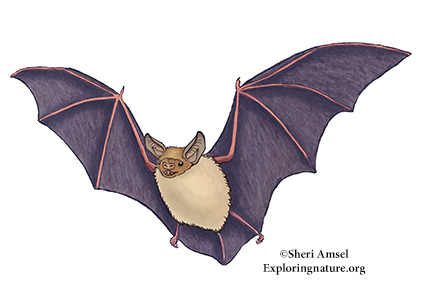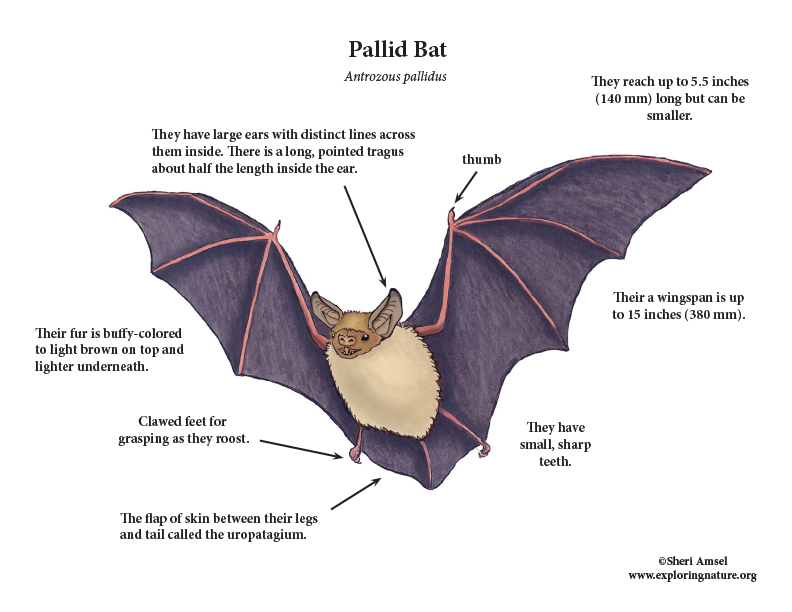

They are found from southwestern Canada, south through the western half through the central U.S. and south to central Mexico.
They live in open, rocky habitats that can be very dry, but are near a water source. They do sometimes roost near humans but are sensitive to being disturbed.
They reach up to 5.5 inches (140 mm) long but can be smaller. Their a wingspan is up to 15 inches. Their fur is buffy-colored to light brown on top and lighter underneath. They have large ears with distinct lines across them inside. There is a long, pointed tragus about half the length inside the ear. There is a flap of skin that stretched between the legs and tail called the uropatagium.
They are nocturnal, hunting at night by using echolocation. Echolocation is a kind of radar that uses the bat’s high-pitched calls to bounce off objects. They can actually “see” what is around them by how their calls bounce off their surroundings. They are territorial and will use their calls to voice if other bats invade their space. When disturbed they can release a skunk-like odor to scare off enemies.
Unlike many bats, the pallid bat does not usually chase flying insects. Instead it hunts prey on the ground or sitting on leaves, like grasshoppers, crickets, beetles, and spiders. They have been known to prey on lizards, small mice and even other bats, but most impressively, the pallid bat can kill and eat scorpions.
They are killed by birds of prey like owls and hawks. This is especially so because they like to hunt over open ground, which makes them in turn prey for bigger predators. When they are on the ground after prey that can be killed by snakes.
They mate in the fall before they start hibernating, but females store the sperm until spring when they become pregnant for about 9 weeks (gestation). They give birth in June to twins and nurse them for up 5 weeks when they begin to fly and can survive on their own. Females roost with their young and other breeding females in a nursery colony.
Can live up to 15 years in the wild. They are not a threatened species.
Kingdom: Animalia
Phylum: Chordata
Subphylum: Vertebrata
Class: Mammalia
Order: Chiroptera
Family: Vespertilionidae
Subfamily: Antrozoinae
Genus: Antrozous
Species: Antrozous pallidus
When you research information you must cite the reference. Citing for websites is different from citing from books, magazines and periodicals. The style of citing shown here is from the MLA Style Citations (Modern Language Association).
When citing a WEBSITE the general format is as follows.
Author Last Name, First Name(s). "Title: Subtitle of Part of Web Page, if appropriate." Title: Subtitle: Section of Page if appropriate. Sponsoring/Publishing Agency, If Given. Additional significant descriptive information. Date of Electronic Publication or other Date, such as Last Updated. Day Month Year of access < URL >.
Amsel, Sheri. "Bat (Pallid)" Exploring Nature Educational Resource ©2005-2024. March 25, 2024
< http://www.exploringnature.org/db/view/468 >

